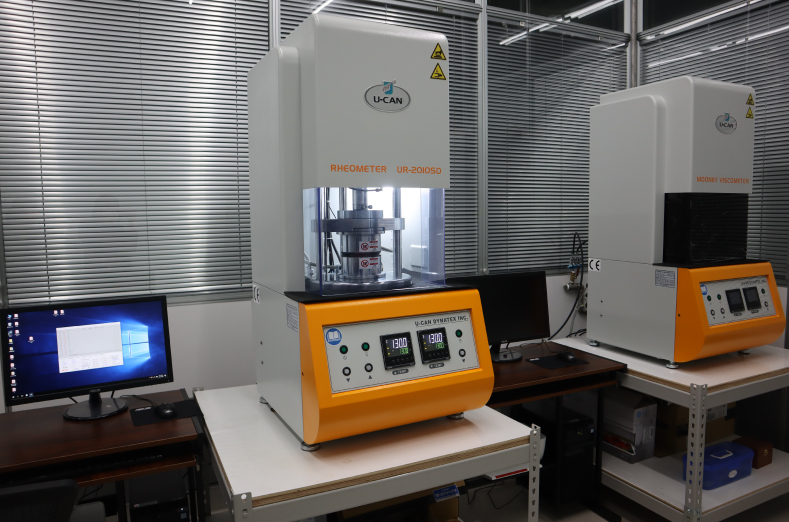
Manufacturing process
Production equipment
Heavy-duty mixer – Kneader (55L)
x 2
Lab-level heavy-duty mixer
x 2
Double-roller mill
x 8
Automatic winding wrapper
x 4
Manual rubberizer
x 4
Manual wrapping work table
x 3 sets
Vulcanizing boiler
x 4
Boiler
x 1
Grinder lathe
x 25
Computer groove cutting machine
x 2
Automatic balancing machine
x 3
Surface roughness tester
x 1
Automatic rubber molding machine
x 1
LSR roller equipment
x 1 set

Rubber research & testing laboratory
To research and improve the production technology and management methods of rubber rollers, ensuring the stability of raw materials and manufactures’ quality, in order to increase the competitiveness of the domestic market.
Materials processed
natural rubber, PU, CR, EPDN, silicone rubber, etc.
Rubber
NR
With excellent workability and physical property, but poor oil resistance, thermal resistance and ozone resistance, NR is generally used widely in tires, shoes, hose, belt and others. Rubber rollers made of NR are suitable for applications that need not thermal resistance, oil resistance but desire low cost.
SBR
SBR has similar nature and uses to NR. In Taiwan, TSRC began producing this synthetic rubber since 1967.
NBR
NBR is oil-resistant synthetic rubber, commonly known as Hycar, and widely used in printing rolls. It has excellent thermal resistance and abrasion resistance.
CR
CR has extraordinary mechanical strength, wear resistance and elasticity, as well as adequate oil resistance, chemical resistance, thermal resistance and ozone resistance. It is widely used in normal industrial rubber rollers.
EPDM
EPDM has poor impact resistant, but is excellent in resistance to polar solvents like ketones and esters. Also, it is of good thermal resistance and chemical resistance. Therefore, EPDM is widely used in rollers for surface treatment and printing and industrial rollers that are thermal or chemical resistant. Its drawback is poor wear resistance.
CSM
CSM is excellent in thermal resistance, chemical resistance, ozone resistance, climate resistance and wear resistance. Its drawback is high price.
PU
Scientifically called as Poly Urethane Rubber, PU has excellent mechanical property, wear resistance and solvent resistance, and has poor thermal resistance and alkaline resistance. It is generally manufactured by liquid-assisted injection molding and widely used industries like iron making, paper making and glazing.
IIR
IIR has polar solvent resistance, thermal resistance and chemical resistance but is poor in oil resistance, elasticity and workability. It is difficult to vulcanize and is generally used in inner tubes for cars. Rubber rollers of this material are used in printing rolls that are resistant to polar solvents and common thermal resistant industrial rollers.
Silicone rubber
Silicone rubber
Silicone Rubber is resistant to cold and hot conditions (about -70℃ to 300o℃), also excels in resistance to cold weather. Being adhesive, it is widely used in PE extrusion & attaching rollers, PVC sheet embossing rollers and tape guiding rollers. Besides, it is also used in other applications like heat seal rollers and sizing rolls. Its drawbacks are weak mechanical property and high price.
Grooving
Cone-shape
Double helical groove
Square lattice groove
Left-hand helical groove
Right-hand helical groove
Diamond cut groove
Horizontal groove
Vertical groove
Grinding
Concave grinding
Convex grinding
Various kinds of grinding
Precision grinding